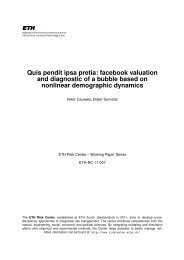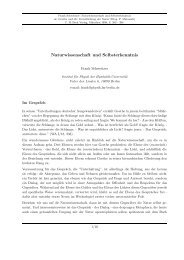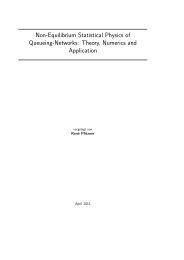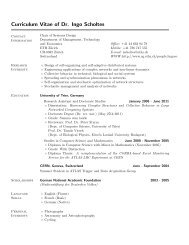Using Laboratory Experiments to Study Law and Crime - Chair of ...
Using Laboratory Experiments to Study Law and Crime - Chair of ...
Using Laboratory Experiments to Study Law and Crime - Chair of ...
Create successful ePaper yourself
Turn your PDF publications into a flip-book with our unique Google optimized e-Paper software.
approaches are successful is far from clear.3Three prominent bodies <strong>of</strong> work explore the issue. Two <strong>of</strong> them, ecological studies (forthe pioneering work see Gibbs, 1968; Sellin, 1961; Tittle, 1969) <strong>and</strong> interrupted time seriesanalyses (see, for example, Sherman, 1990) find little if any effect <strong>of</strong> policies that increase theseverity <strong>of</strong> punishment. Work on specific crack-downs on crimes such as drug dealing showinitial deterrent effects that decline over time, such that crime rates rebound (MacCoun <strong>and</strong>Reuter, 1998; Zimring et al., 2001). A third body <strong>of</strong> work uses surveys <strong>to</strong> ask respondents abouttheir perceptions <strong>of</strong> the risks <strong>and</strong> costs <strong>of</strong> being caught <strong>and</strong> their own self-reported deviant <strong>and</strong>criminal behavior. These studies tend <strong>to</strong> find correlations between perceptions <strong>of</strong> punishment<strong>and</strong> behavior (Cook, 1980; Grasmick <strong>and</strong> Bryjak, 1980; Jensen, 1969; Lochner, 2007; Matsueda,2006; Paternoster, 1987).Why the discrepancy in the findings? One answer is that there is a gap between theseverity <strong>of</strong> punishment dem<strong>and</strong>ed by policy changes <strong>and</strong> perceptions <strong>of</strong> punishment severityamong citizens. Nagin (1998) argues that “for crime control policy <strong>to</strong> be effective it must alterthese perceptions. Evidence on whether <strong>and</strong> how policy in current <strong>and</strong> prior time periods . . .affects sanction perceptions is fragmentary. Ecological <strong>and</strong> interrupted time-series studies havefocused only on the relationship <strong>of</strong> policy <strong>to</strong> crime. In doing so these studies have treated theintervening policy-<strong>to</strong>-perceptions linkage. . . as a black box. . . While these studies generally findthat policy has at least a temporary effect on crime <strong>and</strong> thereby somehow influences perceptions,the dearth <strong>of</strong> evidence on the policy-<strong>to</strong>-perceptions linkage is a major gap in knowledge. . . .[S]uch knowledge would be <strong>of</strong> great value in designing effective deterrence policies” (p. 7).Why might there be a gap between policy <strong>and</strong> perceptions? One possible reason is thatwhat is stated in policy may not actually be what is implemented. Some argue, for example, thatwhen punishments are <strong>to</strong>o severe, they are less likely <strong>to</strong> be imposed. There are numerous reasonsfor this including that because it is <strong>of</strong>ten more costly <strong>to</strong> impose harsher punishments theresources <strong>to</strong> do so may not be available, <strong>and</strong> that people may be less willing <strong>to</strong> impose severepunishments for relatively minor <strong>of</strong>fenses.15







